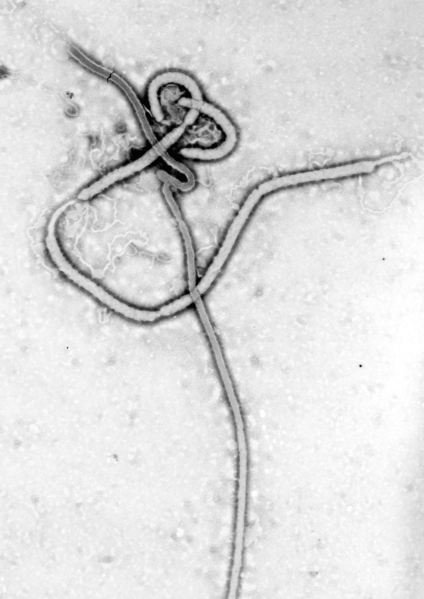tóng-àn:Ebola virus em.png

Seng khoàⁿ chiàm-liōng: 424 × 599 siōng-sò͘. Kî-thaⁿ--ê kái-sek-tō͘: 170 × 240 siōng-sò͘ | 340 × 480 siōng-sò͘ | 543 × 768 siōng-sò͘ | 724 × 1,024 siōng-sò͘ | 2,043 × 2,887 siōng-sò͘.
Choân kái-sek-tō͘ (2,043 × 2,887 siōng-sò͘ , tóng-àn chiàm-liōng: 2.55 MB, MIME luī-hêng: image/png)
Tóng-àn le̍k-sú
Chhi̍h ji̍t-kî/sî-kan, khoàⁿ hit sî-chūn--ê tóng-àn.
| Ji̍t-kî/Sî-kan | 細張圖 | 寸尺 | Iōng-chiá | Chù-kái | |
|---|---|---|---|---|---|
| hiān-chāi | 2014-nî 7-goe̍h 28-ji̍t (pài-it) 09:33 |  | 2,043 × 2,887(2.55 MB) | Splintercellguy | Upload higher-resolution version |
| 2005-nî 5-goe̍h 24-ji̍t (pài-jī) 11:22 |  | 150 × 227(19 KB) | Knutux | An electron micrograph of an Ebola viral particle showing the characteristic filamentous structure of a Filoviridae. The viral filaments can appear in images in various shapes including a 'u', '6', a coil, or branched resul |
Iáⁿ-siōng liân-kiat
Í-hā ê ia̍h liân kàu chit ê iáⁿ-siōng:
tóng-àn hō͘ lâng sái--ê chōng-hóng
Ē-kha--ê kî-thaⁿ wiki ēng tio̍h chit--ê tóng-àn:
- af.wikipedia.org hō͘ lâng ēng--ê chêng-hêng
- als.wikipedia.org hō͘ lâng ēng--ê chêng-hêng
- ar.wikipedia.org hō͘ lâng ēng--ê chêng-hêng
- arz.wikipedia.org hō͘ lâng ēng--ê chêng-hêng
- ast.wikipedia.org hō͘ lâng ēng--ê chêng-hêng
- bn.wikipedia.org hō͘ lâng ēng--ê chêng-hêng
- ca.wikipedia.org hō͘ lâng ēng--ê chêng-hêng
- ca.wikinews.org hō͘ lâng ēng--ê chêng-hêng
- csb.wikipedia.org hō͘ lâng ēng--ê chêng-hêng
- da.wikipedia.org hō͘ lâng ēng--ê chêng-hêng
- de.wikipedia.org hō͘ lâng ēng--ê chêng-hêng
- el.wikipedia.org hō͘ lâng ēng--ê chêng-hêng
- en.wikipedia.org hō͘ lâng ēng--ê chêng-hêng
- Wikipedia:Main Page/French
- Wikipedia:WikiProject Viruses/Templates
- Virus
- Wikipedia:Top 25 Report/July 27 to August 2, 2014
- Wikipedia:Top 25 Report/August 3 to 9, 2014
- RVSV-ZEBOV vaccine
- CAd3-ZEBOV
- 2016 in science
- Wikipedia:Top 25 Report/Records
- User:M1Abramstanbks/sandbox
- Wikipedia:In the news/Posted/May 2004
- en.wikinews.org hō͘ lâng ēng--ê chêng-hêng
- eo.wikipedia.org hō͘ lâng ēng--ê chêng-hêng
- eo.wikinews.org hō͘ lâng ēng--ê chêng-hêng
- es.wikipedia.org hō͘ lâng ēng--ê chêng-hêng
- et.wikipedia.org hō͘ lâng ēng--ê chêng-hêng
- eu.wikipedia.org hō͘ lâng ēng--ê chêng-hêng
- fi.wikiversity.org hō͘ lâng ēng--ê chêng-hêng
- fr.wikipedia.org hō͘ lâng ēng--ê chêng-hêng
- fr.wikibooks.org hō͘ lâng ēng--ê chêng-hêng
- ga.wikipedia.org hō͘ lâng ēng--ê chêng-hêng
- gl.wikipedia.org hō͘ lâng ēng--ê chêng-hêng
檢視此檔案的更多全域使用狀況。


